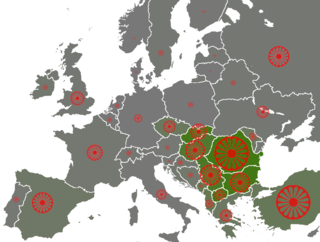
The Romani, also spelled Romany or Rromani, colloquially known as the Roma, are an Indo-Aryan ethnic group who traditionally lived a nomadic, itinerant lifestyle. Linguistic and genetic evidence suggests that the Romani originated in the Indian subcontinent; in particular, the region of present-day Rajasthan. Their subsequent westward migration, possibly in waves, is now believed by historians to have occurred around 1000 CE. Their original name is from the Sanskrit word डोम (doma) and means a member of a Dalit caste of travelling musicians and dancers. The Roma population moved west into the Persian Ghaznavid Empire and later into the Byzantine Empire. The Roma arrived in Europe around the 13th to 14th century. Although they are dispersed, their most concentrated populations are located in Bulgaria, Romania, Hungary, Turkey and Spain.

The Romani Holocaust or the Romani genocide was the planned effort by Nazi Germany and its World War II allies and collaborators to commit ethnic cleansing and eventually genocide against European Roma and Sinti peoples during the Holocaust era.

Radmila Šekerinska Jankovska is the former defense minister of North Macedonia and a former leader of the Social Democratic Union of Macedonia (SDSM). Šekerinska was previously Deputy Prime Minister for European Integration and National Coordinator for Foreign Assistance of North Macedonia and also was the acting Prime Minister of North Macedonia from 12 May 2004 until 12 June 2004 and from 3 November 2004 until 15 December 2004. She was elected 5 November 2006 the SDUM leader. She is the first female (acting) prime minister of North Macedonia.
The Romani language has for most of its history been an entirely oral language, with no written form in common use. Although the first example of written Romani dates from 1542, it is not until the twentieth century that vernacular writing by native Romani people arose.
In 2008 there were about 500-700 Romani people in Mitrovica refugee camps. These three camps were created by the UN in Kosovo. The camps are based around disused heavy metals mines which have fallen out of use since the end of the Kosovo War of 1999. There have been complaints that the residents are suffering severe lead poisoning. According to a 2010 Human Rights Watch, Romani displaced from the Romani quarter in Mitrovica, due to its destruction in 2000, continued to be inmates of camps in north Mitrovica, where they were exposed to environmental lead poisoning.
The Romani people, also referred to as Roma, Sinti, or Kale, depending on the subgroup, are an Indo-Aryan ethnic group that primarily lives in Europe. The Romani may have migrated from what is the modern Indian state of Rajasthan, migrating to the northwest around 250 BC. Their subsequent westward migration, possibly in waves, is now believed to have occurred beginning in about 500 AD. It has also been suggested that emigration from India may have taken place in the context of the raids by Mahmud of Ghazni. As these soldiers were defeated, they were moved west with their families into the Byzantine Empire.

The Romani people are a distinct ethnic and cultural group of peoples living all across the globe, who share a family of languages and sometimes a traditional nomadic mode of life. Though their exact origins are unclear, central India is a notable point of origin. Their language shares a common origin with, and is similar to, modern-day Gujarati and Rajasthani, borrowing loan words from other languages as they migrated from India. In Europe, even though their culture has been victimized by other cultures, they have still found a way to maintain their heritage and society. Indian elements in Romani culture are almost non-existent, with the exception of their language. Romani culture focuses heavily on family. The Roma traditionally live according to relatively strict moral codes. The ethnic culture of the Romani people who live in central, eastern and southeastern European countries developed through a long, complex process of continuous active interaction with the culture of their surrounding European population.

The Romani flag or the flag of the Roma is the international ethnic flag of the Romani people, historically known as "Gypsies", which form a stateless minority in countries across Eurasia, Africa, the Americas, and Australasia. It was approved by the representatives of various Romani communities at the first and second World Romani Congresses (WRC), in 1971 and 1978. The flag consists of a background of blue and green, representing the heavens and earth, respectively; it also contains a 16-spoke red dharmachakra, or cartwheel, in the center. The latter element stands for the itinerant tradition of the Romani people and is also an homage to the flag of India, added to the flag by scholar Weer Rajendra Rishi. It superseded a number of tribal emblems and banners, several of which evoked claims of Romani descent from the Ancient Egyptians.

Šuto Orizari, often shortened as Šutka (Шутка), is one of the ten municipalities that make up the City of Skopje, the capital of the Republic of North Macedonia. Šuto Orizari is also the name of the urban neighbourhood where the municipal seat is located. It consists of a council and mayor.

The World Romani Congress is a series of forums for discussion of issues relating to Roma people around the world. As of 2023, there have been eleven World Romani Congresses. Among the chief goals of these congresses have been the standardization of the Romani language, improvements in civil rights and education, preservation of the Roma culture, reparations from World War II, and international recognition of the Roma as a national minority of Indian native origin.

The International Romani Day is a day to celebrate Romani culture and raise awareness of the issues facing Romani people.

Romani people in Bulgaria constitute Europe's densest gypsy minority. The Romani people in Bulgaria may speak Bulgarian, Turkish or Romani, depending on the region.

Esma Redžepova-Teodosievska was a Macedonian Romani vocalist, songwriter and humanitarian. She was nicknamed "the Queen of the Gypsies" per her contribution to Romani culture and music.

Anti-Romani sentiment is a form of bigotry which consists of hostility, prejudice, discrimination, racism and xenophobia which is specifically directed at Romani people. Non-Romani itinerant groups in Europe such as the Yenish, Irish and Highland Travellers are frequently given the name "gypsy" and as a result, they are frequently confused with the Romani people. As a result, sentiments which were originally directed at the Romani people are also directed at other traveler groups and they are frequently referred to as "antigypsy" sentiments.

The Romani people have several distinct populations, the largest being the Roma and the Calé, who reached Anatolia and the Balkans in the early 12th century, from a migration out of the Indian subcontinent beginning about 1st century – 2nd century AD. They settled in the areas of present-day Turkey, Greece, Serbia, Romania, Croatia, Moldova, Bulgaria, North Macedonia, Hungary, Albania, Kosovo, Bosnia and Herzegovina, Czech Republic, Slovenia and Slovakia, by order of volume, and Spain. From the Balkans, they migrated throughout Europe and, in the nineteenth and later centuries, to the Americas. The Roma population in the United States is estimated at more than one million.
The Romani people are also known by a variety of other names; in English as gypsies or gipsies, and Roma; in Greek as γύφτοι (gíftoi) or τσιγγάνοι (tsiggánoi), in Central and Eastern Europe as Tsingani ; in France as gitans besides the dated terms bohémiens and manouches; in Italy as rom and sinti besides the dated terms zingari, zigani, and gitani; in Spain as gitanos; and in Portugal and Brazil as ciganos.
The deportation of Roma migrants from France was subject of intense political debate in France and internationally in 2009 and 2010. After two fatal incidents, President of France Nicolas Sarkozy vowed in July 2010 to evict at least half of the 539 Roma squatted land camps. The Government of France initiated a program to repatriate thousands of Romanian and Bulgarian Roma, as part of the crackdown. Between July and September 2010, at least 51 Roma camps were demolished, and France has repatriated at least 1,230 Roma to Romania and Bulgaria.

Romani Americans are Americans who have full or partial Romani ancestry. It is estimated that there are one million Romani people in the United States. Though the Romani population in the United States has largely assimilated into American society, the largest concentrations are in Southern California, the Pacific Northwest, Southwestern United States, Texas, Louisiana, Florida and the Northeast as well as in cities such as Chicago and St. Louis.

Santino Spinelli is an Italian Romani musician, composer and teacher.











